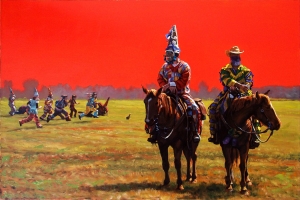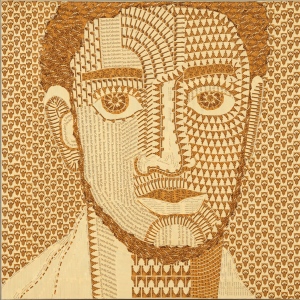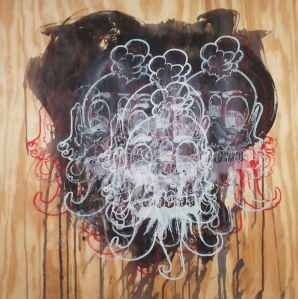by Reggie Michael Rodrigue
“All the soarings of my mind begin in my blood.”
― Rainer Maria Rilke
“One should always be drunk. That’s all that matters…But with what? With wine, with poetry, or with virtue, as you choose. But get drunk.”
― Charles Baudelaire

John Hathorn, “A Note on Red,” oil on canvas, glass, oil, pigment, metal, string, 2000, collection of Lucy Leslie, photograph courtesy of the author
Near the entrance to “John Hathorn – A Retrospective” at the Acadiana Center for the Arts, there is a small, rather unassuming painting on the title wall of the exhibition. It is a vertically oriented, rectangular canvas which has been treated with a thin, umber, oil paint wash and slathered with a thick impasto of red oil paint which virtually obliterates the support surface. The red paint was probably built up with the help of a palette knife over the course of several days or weeks or months … maybe even years? The skin of the painting is as luscious and dense as cake frosting, but looking at it feels more like looking a slab of bloody meat. An old specimen vile containing powdered, red pigment hangs from the bottom of the canvas, calling extra attention to the not-so-secret ingredient that makes this painting hit one square between the eyes. One’s pulse quickens. One’s mouth moistens. Desire takes hold, and the color red is in the driver’s seat.
Hathorn’s “A Note on Red” is a sensual powerhouse; yet there is something extremely lucid and cerebral about it as well with that preserved vile of pigment hanging there from that red dwarf of a canvas, proclaiming that emotion is as easy to produce in the human species as parading colored dust before our eyes. There is poetry in that idea, despite (or, possibly, because of) the Pavlovian inanity of it.

John Hathorn, “Suspension in Red,” oil, tar on canvas, wood, cloth, rope and metal. 1985, collection of H. Gordon Brooks II, photograph courtesy of the author
In the heart of Hathorn’s exhibition, another painting, “Suspension in Red,” continues the artist’s exploration of the expressive power of the color. Here, the color red sets the scene for an abstract treatise on tension.

John Hathorn, “The Grammar of Verbenas (For Darrel Bourque),” oil and conte’ crayon on canvas, 2012, photograph courtesy of the author
Further along in the exhibition, on the back wall of the ACA’s Main Gallery, one can view Hathorn’s “The Grammar of Verbenas (For Darrel Bourque),” a monolithic painting composed of a cataract of paint strokes, smudges and drips in midnight blue, black, burnt sienna and cadmium yellow on a white canvas. A scrawled line from a poem by Louisiana’s 2009-2010 Poet Laureate, Darrell Bourque, hems the right edge of the composition like the inscriptions one can find on the edges of Japanese and Chinese prints. The inscription reads “one burnt water flowing into another burnt water.”
Here, the abstract image is primary, yet the inscription – the addition of language – adds focus and direction to the image. Language makes the image more concrete and discernible, pinning it down while it seems to still wriggle with a mysterious life force of its own. Yet, the inscription leaves one to question what exactly “burnt water” is. The answer lies in the meaning behind Bourque’s poem, which concerns the consummation and obliteration of the dichotomous elements of creation to create new substances or new life – hence the paradox of “burnt water.” It is a metaphor for the way that oppositional forces and drives engender creation.
This fusion of opposites – the sensual and the cerebral – is the basis for all art. However, John Hathorn makes this fusion something overt. He makes the connection between the mind and the body the subject of his art by juxtaposing the sheer beauty of paint doing what it does on canvas with objects from the “real world” and fragments of literature, creating a trinity of human thought, gesture and artifact that stands in for the sum total of human aspiration and creation. In the end, he falls short of this goal, but anyone foolhardy enough to attempt such a thing would. What he does is manage to bring us closer to the goal which is valid in and of itself if one ascribes to the idea that “Life is a journey, not a destination.”

John Hathorn, “Raft,” wood, rope, stone, salt, metal, oil, cloth, paper, ink, floor to ceiling suspended installation, 2012, photograph courtesy of the author

Detail from John Hathorn’s “Raft,” photograph courtesy of the author

Detail from John Hathorn’s “Raft,” photograph courtesy of the author

Detail from John Hathorn’s “Raft,” photograph courtesy of the author

Detail from John Hathorn’s “Raft,” photograph courtesy of the author

Detail from John Hathorn’s “Raft,” photograph courtesy of the author
Speaking of journeys, it is somewhat easy to fantasize about taking one on Hathorn’s sublime “Raft.” The sculpture is a wooden platform covered with rugs, paintings, drawings, personal notes and other objects which hovers inches above the floor of the gallery and is suspended from the ceiling via a sturdy rope. The other end of the rope is wrapped and tied around a wooden palette topped by stone slabs and salt blocks on the other side of the gallery. The piece dominates the entrance to the exhibition.
Hathorn’s “Raft” looks like a cross between a raft, a magic carpet, a cabinet of curiosities, a studio, a DaVinci-esque science project and a construction site – all things which speak to exoticism, travel, transformation from one state to another, and/or a belief in or a hope for a better future. It is a highly personal, artistic gesture in that Hathorn used lumber left over from the construction of the studio he shares with his wife, artist Mary Ellen Leger, to make the piece. Add to that the personal ephemera and paraphernalia from Hathorn’s own practice in the completed studio, and one has access to a slice of the artist’s life, work and process combined.
Yet, Hathorn’s aspirations for the piece go beyond the personal and move toward the universal and the Romantic. One of the inspirations for the piece is Theodore Gericault’s masterpiece “The Raft of the Medusa,” a 19th century painting depicting the aftermath of the shipwreck of a French frigate off the coast of Senegal in 1816. Another inspiration for “Raft” is William Shakespeare’s play “The Tempest,” which unfolds around the central character of Prospero, a deposed duke and a magus who is trapped on a deserted island. In the play, Prospero plots to regain his title by unleashing a storm on his enemies while they are at sea which causes their ship to wreck, forcing them onto the shores of Prospero’s island where he reigns supreme. Between these allusions and the physical manifestation of “Raft” itself, one is set adrift to peruse the individual materials that together compose the work and ponder what it means to seek and find refuge in uncertain times. In Hathorn’s case, text, image and personal effects fuse to create a secure and fertile ground upon which his life and creative spirit thrive.

Installation view of John Hathorn’s work table display in “John Hathorn – A Retropsective,” photograph courtesy of the author

A painting on John Hathorn’s work table display in “John Hathorn – A Retrospective,” photograph courtesy of the author

An assemblage on John Hathorn’s work table display in “John Hathorn – A Retrospective,” photograph courtesy of the author

An assembalge on John Hathorn’s work table display in “John Hathorn – A Retrospective,” photograph courtesy of the author
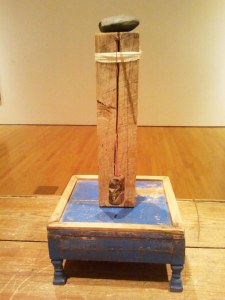
An assemblage on John Hathorn’s work table display in “John Hathorn – A Retrospective,” photograph courtesy of the author

An assemblage suspended over John Hathorn’s work table display in “John Hathorn – A Retrospective,” photograph courtesy of the author

Two assemblages suspended over John Hathorn’s work table display in “John Hathorn – A Retrospective,” photograph courtesy of the author

A waste basket filled with used paint tubes near John Hathorn’s work table display in “John Hathorn – A Retrospective,” photograph courtesy of the author
A more diffuse but still compelling assembly within the exhibition is Hathorn’s work table topped with diminutive paintings and rough-hewn, little objets d’art, some of which were made as tokens of affection for his wife. The alchemical role of the artist is on display here, exposing the small but fruitful experiments and transformations of paint, objects and texts which underpin the larger works in the exhibition. With the table display, one can gain a better perspective on the artist’s process, and it is one of my favorite parts of the exhibition. I especially love the waste basket filled with used paint tubes near the table. Rather than being a side note on waste and consumption, it’s proximity to the table gives it the air of something poetic, beautiful and grand. It is transfigured into an accidental monument to love and passion for one’s craft.

John Hathorn, “Large Palette,” oil on wood mounted on steel rod in wood base, 1994-1996, one of two individual palette sculptures on display in “John Hathorn – Retrospective,” photograph courtesy of the author

John Hathorn, “Cardinal,” oil on canvas, steel plumb, string, wood, oil on wooden ironing board, 1996, photograph courtesy of the author
Elsewhere in the exhibition, one comes into contact with more paintings-cum-sculptures that explore the various themes inherent in Hathorn’s ouevre: the physical qualities of thickly impastoed paint, emphasis on the expressive and symbolic qualities of color, the elevation and suspension of objects, and an interrogation of the nature of painting and sculpture.

John Hathorn, “Large Bather,” oil on canvas, wood, glass, oil, pigment, 1997, collection of Darrell and Karen Bourque, photograph courtesy of the author

John Hathorn, ‘The Grammar of Water (Seventh State),” oil on canvas, 2006, photograph courtesy of the author
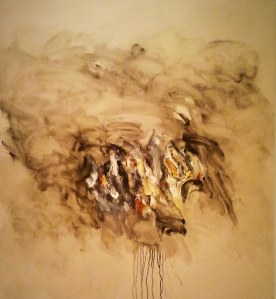
John Hathorn, “The Grammar of Water (Twelfth State),” oil on canvas, 2006, photograph courtesy of the author
There is also the running theme of water through the exhibition. Beside the aforementioned “The Grammar of Verbenas (For Darrell Bourque)” and “Raft,” with their allusions to water, there is the presence of “Large Bather” and “The Grammar of Water (Seventh State)” and “The Grammar of Water (Twelfth State).” In “Large Bather,” Hathorn aspires to capture some of the abstract play between water and light in some of the Dutch master Rembrandt van Rijn’s paintings, such as “Woman Bathing” of 1654. In Hathorn’s painting, we are given the tenebrous atmosphere of Rembrandt’s background, thick, painterly gestures standing in for the rich cloth depicted behind the Rembrandt’s bathing beauty and a bottle of amber liquid on a shelf to exemplify the interplay between light and water. With the “Grammar of Water” paintings, Hathorn simply focuses on color and gesture to achieve a painterly language to convey water’s various guises.

John Hathorn, “The Baudelaire Sketches (The Silence of the Void)” oil and charcoal on canvas, cord, metal, water faucet, 2009-2010, photograph courtesy of the author

John Hathorn, “The Desire to Paint (On Baudelaire,” oil on canvas, oil on wood, typewriter, glass, oil and string, 1998, photograph courtesy of the author

John Hathorn, “The Benefits of the Moon (On Baudelaire)”, oil on canvas, music stand, oil on panel, stone, oil can, wood, glass, pigment, ivory, 1998-2002, photograph courtesy of the author
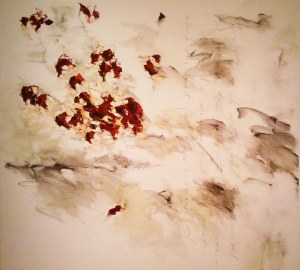
John Hathorn, “The Baudelaire Sketches (Of a Miraculous Plant)” oil and charcoal on canvas, 2009-2012, photograph courtesy of the author

John Hathorn, “The First Word of a Poem (On Rilke),” oil and conte’ on canvas, 2012, photograph courtesy of the author
The allusions to water continue in Hathorn’s “Baudelaire Sketches” with the deployment of a suspended faucet in the painting “The Baudelaire Sketches (The Silence of the Void).” Here Hathorn rifts on the work of famed French poet Charles Baudelaire, inscribing lyrics from a poem by the author directly onto the canvas in a black scrawl and using the words as a generative element to create an image of absence. The faucet serves to trigger the memories that we all have of faulty faucets leaking water loudly in otherwise silent rooms and the loneliness and isolation of the sound.
Baudelaire looms large in Hathorn’s work because, according the artist himself, Baudelaire “used words as a physical reality … Like Baudelaire’s abstraction of language, I use paint’s physicality as the language of my art making” (from an artist’s statement in “John Hathorn – A Retrospective”). In a very real sense, Hathorn and the French poet are spiritual and artistic kin, sucking the marrow out of the physical engagements of life and the sensations they engender and transmuting these things into an art of felt experience, symbolic inquiry, and metaphysical significance. Hathorn views his work as a form of correspondence across the centuries between himself and Baudelaire. This, among other correspondences, creates a temporal shift in much of the work that seems retardaire, nostalgic or simply elegiac. The irony here is that Baudelaire was considered an avatar of modern literature in his own time and a prototype for the avante garde of the 20th century.
Another literary figure Hathorn communes with is the German poet Rainer Maria Rilke. The poet’s work generally juxtaposes stark yet lyrical physical imagery with a transcendent spirituality poised on the cusp of a pantheistic mysticism and existential angst. Though his work comes from the turn of the 19th into the 2oth century, Rilke seems to be a poet for our times as well in that the forces set into play in his own works are forces that we recognize in our own lives. His naked and direct, yet elegant, lines appeal to our sensibility for simple, unadorned language while between the lines, one gets the sense that he is reaching out for something far more obscure, yet profoundly nourishing. One can get the same sense of simplicity and profundity from Hathorn’s work.
There are other antecedents for Hathorn’s work as well, and they come from the visual arts. However, they aren’t mentioned in the exhibition: they are the Abstract Expressionsists, namely Philip Guston and Willem de Kooning, and the group of artists that immediately superseded them, such as Robert Rauschenberg and Cy Twombly. In their combined works lie the seeds for everything that John Hathorn undertakes and subtly yet personally transforms in his own work. He is in their debt for certain. This is no slight, however. It is the position of all artists to be in debt to someone or something. If we are worth anything, we choose to stand on the shoulders of giants.
With all of its correspondences with authors and artists from the past, Hathorn’s work may seem like a throwback to another era with it’s denial of the trademark tropes of contemporary art: the fixation on advertising, graphic design, and celebrity, the slick appeal of minimalism, the shock of graphic and taboo imagery, the chic deshabille of a pile of trash thrown together, the divisiveness of identity art, and the transitory and shape-shifting nature of digitalia and the New Aesthetic, along with the theatrics of performance art and relational aesthetics.
All of these things seem a long way from Hathorn’s ouevre, and rightly so. For Hathorn has conceived of a world for himself that operates at a slower pace, is more contemplative, quieter, subtler and richer than the outside world, if not as complex. The conundrum is that a complex world with ever-increasing demands on time and resources often breeds glib and facile art or conversely art that is so chaotic as to leave one feeling lost in it.
Therefore, it is an invaluable treat to be in the presence of an art which allows for a slow read and a chance to look back into the vast sea of art and literature from the past – not to dredge for kitsch, mind you, but to rediscover what is valuable, timeless and essential and return it to the light of day. Hathorn reminds us that we are most human when we contemplate the connection between mind, body and spirit. This connection has sustained humanity on it’s long journey through the centuries.
As long as we continue to forge and refine this connection, we will find comfort and refuge in our creations – the glorious life-rafts of our own making.
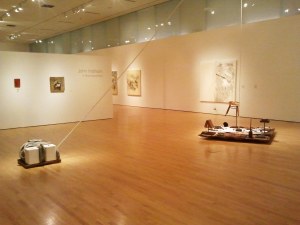
Installation view of “John Hathorn – A Retrospective” at the Acadiana Center for the Arts, photograph courtesy of the author

Installation view of “John Hathorn – A Retrospective” at the Acadiana Center for the Arts, photograph courtesy of the author
“John Hathorn – A Retrospective” is on view at the Acadiana Center for the Arts until April 13, 2013.




